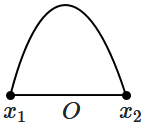A particle of mass \(m\) oscillates with simple harmonic motion between points \(x_1\) and \(x_2\), the equilibrium position being \(O\). Its potential energy is plotted. It will be as given below in the graph:
| 1. |  |
2. |  |
| 3. |  |
4. |  |
1. \(x = \pm a\)
2. \(x = \pm \frac{a}{2}\)
3. \(x = \pm \frac{a}{\sqrt{2}}\)
4. \(x = \pm \frac{\sqrt{3}a}{2}\)
The potential energy of a simple harmonic oscillator, when the particle is halfway to its endpoint, will be:
1. \(\frac{2E}{3}\)
2. \(\frac{E}{8}\)
3. \(\frac{E}{4}\)
4. \(\frac{E}{2}\)
1. \(\frac{1}{2}\)
2. \(\frac{1}{4}\)
3. \(1\)
4. \(\frac{1}{8}\)

1. \(\frac{\pi}{2}~\text{s}\)
2. \(\frac{1}{2}~\text{s}\)
3. \(\pi~\text{s}\)
4. \(1~\text{s}\)
A block of mass \(4~\text{kg}\) hangs from a spring of spring constant \(k = 400~\text{N/m}\). The block is pulled down through \(15~\text{cm}\) below the equilibrium position and released. What is its kinetic energy when the block is \(10~\text{cm}\) below the equilibrium position? [Ignore gravity]
1. \(5~\text{J}\)
2. \(2.5~\text{J}\)
3. \(1~\text{J}\)
4. \(1.9~\text{J}\)
1. \(2\pi \sqrt{\frac{q}{p}}\)
2. \(2\pi \sqrt{\frac{p}{q}}\)
3. \(2\pi \sqrt{\frac{q}{p+q}}\)
4. \(2\pi \sqrt{\frac{p}{p+q}}\)
1. \(\propto x\)
2. \(\propto x^2\)
3. Independent of \(x\)
4. \(\propto x^{\frac{1}{2}}\)
| 1. | Zero | 2. | \(30~\text{J}\) |
| 3. | \(20~\text{J}\) | 4. | \(40~\text{J}\) |
1. \(\pm \frac{a}{2}\)
2. \(+a\)
3. \(\pm a\)
4. \(-1\)






